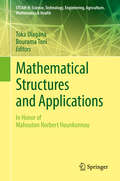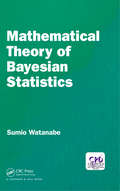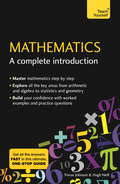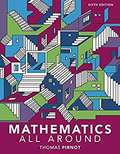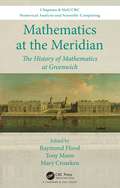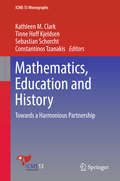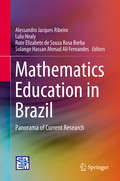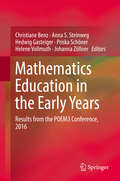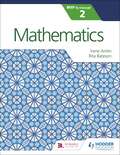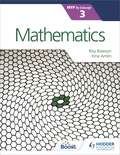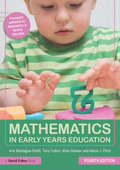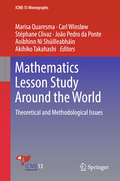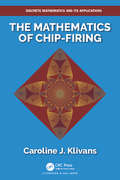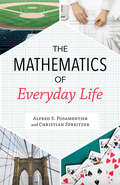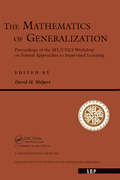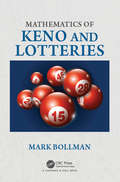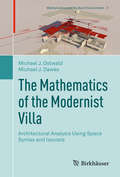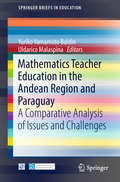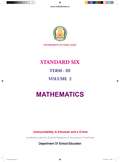- Table View
- List View
Mathematical Structures and Applications: In Honor Of Mahouton Norbert Hounkonnou (STEAM-H: Science, Technology, Engineering, Agriculture, Mathematics & Health)
by Toka Diagana Bourama ToniThis contributed volume features invited papers on current research and applications in mathematical structures. Featuring various disciplines in the mathematical sciences and physics, articles in this volume discuss fundamental scientific and mathematical concepts as well as their applications to topical problems. Special emphasis is placed on important methods, research directions and applications of analysis within and beyond each field. Covered topics include Metric operators and generalized hermiticity, Semi-frames, Hilbert-Schmidt operator, Symplectic affine action, Fractional Brownian motion, Walker Osserman metric, Nonlinear Maxwell equations, The Yukawa model, Heisenberg observables, Nonholonomic systems, neural networks, Seiberg-Witten invariants, photon-added coherent state, electrostatic double layers, and star products and functions. All contributions are from the participants of the conference held October 2016 in Cotonou, Benin in honor of Professor Mahouton Norbert Hounkonnou for his outstanding contributions to the mathematical and physical sciences and education. Accessible to graduate students and postdoctoral researchers, this volume is a useful resource to applied scientists, applied and pure mathematicians, and mathematical and theoretical physicists.
Mathematical Theory of Bayesian Statistics
by Sumio WatanabeMathematical Theory of Bayesian Statistics introduces the mathematical foundation of Bayesian inference which is well-known to be more accurate in many real-world problems than the maximum likelihood method. Recent research has uncovered several mathematical laws in Bayesian statistics, by which both the generalization loss and the marginal likelihood are estimated even if the posterior distribution cannot be approximated by any normal distribution. <P><P> Features <li>Explains Bayesian inference not subjectively but objectively. <li>Provides a mathematical framework for conventional Bayesian theorems. <li>Introduces and proves new theorems. <li>Cross validation and information criteria of Bayesian statistics are studied from the mathematical point of view. <li>Illustrates applications to several statistical problems, for example, model selection, hyperparameter optimization, and hypothesis tests. <li>This book provides basic introductions for students, researchers, and users of Bayesian statistics, as well as applied mathematicians. <P><P>Author <P><P>Sumio Watanabe is a professor of Department of Mathematical and Computing Science at Tokyo Institute of Technology. He studies the relationship between algebraic geometry and mathematical statistics.
Mathematics: Bullet Guides
by Sophie GoldieOpen this book and you will Be numerate Understand key principles Conquer difficult problems Handle data confidently
Mathematics: The Easy Way to Learn Maths
by Hugh Neill Trevor JohnsonMaths does not have to be difficult. This book, complete with exercises and answers, forms a course which will take you from beginner or intermediate level to being a confident mathematician. This book includes: simple step-by-step explanations, to help you grasp new topics or those that have previously confused you; practice questions throughout, to help you embed your learning and improve your confidence; and end of chapter summaries, to help you remember the key points you've learned - all in one great-value book, so you don't need any separate workbooks or coursebooks.Chapters include: number; angles; fractions; two-dimensional shapes; decimals; statisticsl directed numbers; graphs; measurement; perimeter and area; algebraic expressions; approximations; equations; percentages; formulae; circles; probability; three-dimensional shapes; ratio and proportion; pythagoras' theorem and trigonometry; indices and standard form.ABOUT THE SERIESThe Complete Introduction series from Teach Yourself is the ultimate one-stop guide for anyone wanting a comprehensive and accessible entry point into subjects as diverse as philosophy, mathematics, psychology, Shakespeare and practical electronics. Loved by students and perfect for general readers who simply want to learn more about the world around them, these books are your first choice for discovering something new.
Mathematics All Around
by Tom PirnotGiven their widely varying backgrounds, students in Liberal Arts Math often enter the course with math anxiety. Pirnot’s Mathematics All Around, 6th Edition offers the supportive and patient writing style that students need to overcome that apprehension, developing useful skills through realistic applications that can be seen in the world around them. Relevant and approachable, the author’s tone resembles the support students would receive during an instructor’s office hours. The author emphasizes a problem-solving approach, reinforcing problem-solving methods and how to apply them throughout the text. The 6th Edition keeps students engaged with updated real-world applications, while also providing more support as they learn with new measurable objectives, revised exercise sets, significant enhancements to each chapter, as well as a new student Workbook.
Mathematics at the Meridian: The History of Mathematics at Greenwich (Chapman & Hall/CRC Numerical Analysis and Scientific Computing Series)
by Raymond Flood Tony Mann Mary CroarkenGreenwich has been a centre for scientific computing since the foundation of the Royal Observatory in 1675. Early Astronomers Royal gathered astronomical data with the purpose of enabling navigators to compute their longitude at sea. Nevil Maskelyne in the 18th century organised the work of computing tables for the Nautical Almanac, anticipating later methods used in safety-critical computing systems. The 19th century saw influential critiques of Charles Babbage’s mechanical calculating engines, and in the 20th century Leslie Comrie and others pioneered the automation of computation. The arrival of the Royal Naval College in 1873 and the University of Greenwich in 1999 has brought more mathematicians and different kinds of mathematics to Greenwich. In the 21st century computational mathematics has found many new applications. This book presents an account of the mathematicians who worked at Greenwich and their achievements. Features A scholarly but accessible history of mathematics at Greenwich, from the seventeenth century to the present day, with each chapter written by an expert in the field The book will appeal to astronomical and naval historians as well as historians of mathematics and scientific computing.
Mathematics: Bullet Guides
by Sophie GoldieOpen this book and you will Be numerate Understand key principles Conquer difficult problems Handle data confidently
Mathematics, Education and History: Towards A Harmonious Partnership (ICME-13 Monographs)
by Constantinos Tzanakis Sebastian Schorcht Tinne Hoff Kjeldsen Kathleen M. ClarkThis book includes 18 peer-reviewed papers from nine countries, originally presented in a shorter form at TSG 25 The Role of History of Mathematics in Mathematics Education, as part of ICME-13 during. It also features an introductory chapter, by its co-editors, on the structure and main points of the book with an outline of recent developments in exploring the role of history and epistemology in mathematics education. It serves as a valuable contribution in this domain, by making reports on recent developments in this field available to the international educational community, with a special focus on relevant research results since 2000. The 18 chapters of the book are divided into five interrelated parts that underlie the central issues of research in this domain: 1. Theoretical and conceptual frameworks for integrating history and epistemology in mathematics in mathematics education; 2. Courses and didactical material: Design, implementation and evaluation; 3. Empirical investigations on implementing history and epistemology in mathematics education; 4. Original historical sources in teaching and learning of and about mathematics; 5. History and epistemology of mathematics: Interdisciplinary teaching and sociocultural aspects. This book covers all levels of education, from primary school to tertiary education, with a particular focus on teacher education. Additionally, each chapter refers to and/or is based on empirical research, in order to support, illuminate, clarify and evaluate key issues, main questions, and conjectured theses raised by the authors or in the literature on the basis of historical-epistemological or didactical-cognitive arguments.
Mathematics Education in Brazil: Panorama of Current Research
by Alessandro Jacques Ribeiro Lulu Healy Rute Elizabete Borba Solange Hassan FernandesThis book presents, for the first time in English, the state of the art of Mathematics Education research in Brazil, a country that has the strongest community in this field in Latin America. Edited by leading researchers in the area, the volume provides the international academic community a summary of the scientific production of the thirteen working groups of the Brazilian Society of Mathematics Education (SBEM), the national scientific society that brings together researchers, teachers, students and other professionals of the area. These working groups meet every three years at the International Seminar of Mathematics Education (SIPEM) and cover the following topics: Mathematics Education in the Early Years and Primary Education (Y1-Y5); Mathematics Education in the Middle School (Y6-Y9); Mathematics Education in the High School (Y10-Y12); Mathematics Education at the University level; History of Mathematics, Culture and Mathematics Education; Digital Technologies and Distance Education; Teacher Education; Assessment and Mathematics Education; Cognitive and Linguistic Processes in Mathematics Education; Mathematical Modeling; Philosophy of Mathematics Education, Teaching Probability and Statistics; and Difference, Inclusion and Mathematics Education. Each chapter of the book presents an overview of the production of a working group and they are all preceded by an introduction by professor Ubiratan D’Ambrosio, one of the pioneers of Mathematics Education in Brazil.
Mathematics Education in the Early Years: Results From The Poem3 Conference 2016
by Christiane Benz Hedwig Gasteiger Anna S. Steinweg Priska Schöner Helene Vollmuth Johanna ZöllnerThis book gives insight in the vivid research area of early mathematics learning. The collection of selected papers mirror the research topics presented at the third POEM conference. Thematically, the volume reflects the importance of this relatively new field of research. Structurally, the book tries to guide the reader through a variety of research aims and issues and is split into four parts. The first two parts concentrate on teacher professional development and child learning development; the third part pools research studies creating and evaluating designed learning situations; and the fourth part bridges focuses on parent-child-interaction.
Mathematics for the IB MYP 2
by Rita Bateson Irina AmlinA concept-driven and assessment-focused approach to Mathematics teaching and learning.- Approaches each chapter with statements of inquiry framed by key and related concepts, set in a global context- Supports every aspect of assessment using tasks designed by an experienced MYP educator- Differentiates and extends learning with research projects and interdisciplinary opportunities- Applies global contexts in meaningful ways to offer an MYP Mathematics programme with an internationally-minded perspectiv
Mathematics for the IB MYP 3
by Rita Bateson Irina AmlinA concept-driven and assessment-focused approach to Mathematics teaching and learning.- Approaches each chapter with statements of inquiry framed by key and related concepts, set in a global context- Supports every aspect of assessment using tasks designed by an experienced MYP educator- Differentiates and extends learning with research projects and interdisciplinary opportunities- Applies global contexts in meaningful ways to offer an MYP Mathematics programme with an internationally-minded perspective
Mathematics for the IB MYP 3
by Rita Bateson Irina AmlinA concept-driven and assessment-focused approach to Mathematics teaching and learning.- Approaches each chapter with statements of inquiry framed by key and related concepts, set in a global context- Supports every aspect of assessment using tasks designed by an experienced MYP educator- Differentiates and extends learning with research projects and interdisciplinary opportunities- Applies global contexts in meaningful ways to offer an MYP Mathematics programme with an internationally-minded perspective
Mathematics in Early Years Education
by Alice Hansen Ann Montague-Smith Alison J. Price Tony CottonThis fourth edition of the bestselling Mathematics in Early Years Education provides an accessible introduction to the teaching of mathematics in the early years. Covering all areas of mathematics – number and counting, calculation, pattern, shape, measures and data handling – it provides a wide range of practical activities and guidance on how to support young children’s mathematical development. There is also guidance on managing the transition to KS1 and a strong emphasis throughout on creating home links and working in partnership with parents. This new edition has been fully updated to incorporate the latest research and thinking in this area and includes: why mathematics is important as a way of making sense of the world how attitudes to mathematics can influence teaching and learning how children learn mathematics and what they are capable of learning how technology can support maths teaching maths phobia and the impact society has on maths teaching material on sorting, matching and handling data the importance of educating about finance in today’s world ideas for observation and questioning to assess children’s understanding examples of planned activities suggestions for language development assessment criteria. This textbook is ideal for those training to be teachers through an undergraduate or PGCE route, those training for Early Years Professional Status and those studying early childhood on foundation or honours degrees, as well as parents looking to explore how their young children learn mathematics. This will be an essential text for any early years practitioner looking to make mathematics interesting, exciting and engaging in their classroom.
Mathematics Instruction [Grade] 5 (Ready North Carolina)
by Penny Dowdy Kathy Kellman Ruth Estabrook Pam Halloran Lauren Van Wart Sarah Kraus David PolakoffNIMAC-sourced textbook
Mathematics Lesson Study Around the World: Theoretical And Methodological Issues (ICME-13 Monographs)
by Marisa Quaresma Carl Winsløw Stéphane Clivaz João Pedro da Ponte Aoibhinn Ní Shúilleabháin Akihiko TakahashiThis book introduces the specifics of mathematics lesson study with regard to regional/national particularities, discussing the methodological and theoretical tools that can be used to pursue research on lesson study (its forms, contents, effects etc.) from an international perspective. Lesson study and learning study (LS) are becoming increasingly important in teacher education, mostly in continuous professional development, but also in prospective teachers’ education, and this interest is accompanied by a demand for more solid theorization of the lesson study process. A number of social, cultural, cognitive and affective issues are reflected in the way LS develops, and the book examines the latest results of these developments.
The Mathematics of Chip-Firing (Discrete Mathematics and Its Applications)
by Caroline J. KlivansThe Mathematics of Chip-firing is a solid introduction and overview of the growing field of chip-firing. It offers an appreciation for the richness and diversity of the subject. Chip-firing refers to a discrete dynamical system — a commodity is exchanged between sites of a network according to very simple local rules. Although governed by local rules, the long-term global behavior of the system reveals fascinating properties. The Fundamental properties of chip-firing are covered from a variety of perspectives. This gives the reader both a broad context of the field and concrete entry points from different backgrounds. Broken into two sections, the first examines the fundamentals of chip-firing, while the second half presents more general frameworks for chip-firing. Instructors and students will discover that this book provides a comprehensive background to approaching original sources. Features: Provides a broad introduction for researchers interested in the subject of chip-firing The text includes historical and current perspectives Exercises included at the end of each chapter About the Author: Caroline J. Klivans received a BA degree in mathematics from Cornell University and a PhD in applied mathematics from MIT. Currently, she is an Associate Professor in the Division of Applied Mathematics at Brown University. She is also an Associate Director of ICERM (Institute for Computational and Experimental Research in Mathematics). Before coming to Brown she held positions at MSRI, Cornell and the University of Chicago. Her research is in algebraic, geometric and topological combinatorics.
The Mathematics of Everyday Life
by Alfred S. Posamentier Christian SpreitzerTwo experienced math educators help the average reader discover not only the everyday usefulness of math but the fun that comes from mastering the basics of arithmetic, algebra, geometry, and more.If you think of mathematics as a series of pointless classroom exercises without much relevance to real life, this book will change your mind. As the authors show, math is deeply embedded in almost every aspect of daily life--from managing your personal finances, making consumer purchases, and sharpening your computational skills, to learning to apply mathematical concepts that will give you a better grasp of both ordinary and extraordinary events and help you better appreciate the world we live in. With some basic geometry under your belt, you'll discover that there is an optimal point on a soccer field from which to shoot a goal. And you'll be more clever with the gears of a bike. If you like to play cards or go to the casino, knowing something about probability will give you an edge. You'll also have an enhanced understanding of the "whispering effect" inside the Capitol rotunda, why a car's headlights are so bright, and even why sewer covers are round. After reading this entertaining and instructive book, you'll come away with a whole new awareness of how elegantly mathematics explains everyday experiences and observations--from present day items to classical art and architecture.
The Mathematics Of Generalization: Proceedings: Sfi-cnls Workshop On Formal Approaches To Supervised Learning (1992: Santa Fe, N. M.)
by David. H WolpertThis volume grew out of a workshop designed to bring together researchers from different fields and includes contributions from workers in Bayesian analysis, machine learning, neural nets, PAC and VC theory, classical sampling theory statistics and the statistical physics of learning. The contributions present a bird's-eye view of the subject.
Mathematics of Keno and Lotteries (AK Peters/CRC Recreational Mathematics Series)
by Mark BollmanMathematics of Keno and Lotteries is an elementary treatment of the mathematics, primarily probability and simple combinatorics, involved in lotteries and keno. Keno has a long history as a high-advantage, high-payoff casino game, and state lottery games such as Powerball are mathematically similar. MKL also considers such lottery games as passive tickets, daily number drawings, and specialized games offered around the world. In addition, there is a section on financial mathematics that explains the connection between lump-sum lottery prizes (as with Powerball) and their multi-year annuity options. So-called "winning systems" for keno and lotteries are examined mathematically and their flaws identified.
The Mathematics of the Modernist Villa: Architectural Analysis Using Space Syntax And Isovists (Mathematics And The Built Environment Ser. #3)
by Michael J. Ostwald Michael J. DawesThis book presents the first detailed mathematical analysis of the social, cognitive and experiential properties of Modernist domestic architecture.The Modern Movement in architecture, which came to prominence during the first half of the twentieth century, may have been famous for its functional forms and machine-made aesthetic, but it also sought to challenge the way people inhabit, understand and experience space. Ludwig Mies van der Rohe’s buildings were not only minimalist and transparent, they were designed to subvert traditional social hierarchies. Frank Lloyd Wright’s organic Modernism not only attempted to negotiate a more responsive relationship between nature and architecture, but also shape the way people experience space. Richard Neutra’s Californian Modernism is traditionally celebrated for its sleek, geometric forms, but his intention was to use design to support a heightened understanding of context. Glenn Murcutt’s pristine pavilions, seemingly the epitome of regional Modernism, actually raise important questions about the socio-spatial structure of architecture. Rather than focussing on form or style in Modernism, this book examines the spatial, social and experiential properties of thirty-seven designs by Wright, Mies, Neutra and Murcutt. The computational and mathematical methods used for this purpose are drawn from space syntax, isovist geometry and graph theory. The specific issues that are examined include: the sensory and emotional appeal of space and form; shifting social and spatial structures in architectural planning; wayfinding and visual understanding; and the relationship between form and program.
Mathematics Practice and Problem Solving [Grade] 3 (Ready North Carolina)
by Sarah Kraus David PolakoffNIMAC-sourced textbook
Mathematics Teacher Education in the Andean Region and Paraguay: A Comparative Analysis of Issues and Challenges (SpringerBriefs in Education)
by Uldarico Malaspina Yuriko Yamamoto Baldin Jill AdlerThis book is an excellent synthesis of the initial and continuing preparation for Mathematics Teaching in Bolivia, Ecuador, Paraguay and Peru, from which comparative analyses can be made that show similarities and differences, and highlight various perspectives. In February 2016, the 5th Capacity and Networking Project (CANP) workshop of the International Commission on Mathematical Instruction (ICMI) was held in Lima, Peru. The coordination of this two-week workshop was undertaken by an international scientific committee (IPC), with equal participation by mathematicians and mathematics educators from the region and from the international ICMI and IMU community. The goal of CANP5 was to improve the quality of mathematics education in the region, which led to the main theme of the scientific program “Initial and Continued Teacher Education”. Country Reports on the main theme of teacher education systems for each country in this region were presented and discussed to detect common issues that might be improved through a collaborative network. One of the most important results of this event was the creation of a Mathematics Education Network, namely the Comunidad de Educación Matemática de America del Sur – CEMAS. This book brings to the international Educational Community an important collection of experiences and ideas in the Mathematics Education of four Latin-American countries in the developing Andean region and Paraguay. The dissemination of these results can promote the search for international collaborative actions in a wider scale.
Mathematics Term 3 Volume 2 class 6 - S.C.E.R.T - Tamil Nadu Board
by Tamil GovernmentMathematics Term - III (Volume 2) 6th Standard book introduces the student to the foundations over which the subject had developed in the past, the content it offers now and the changes that it had undergone. Mathematics is a unique symbolic language in which the world works and acts so. This textbook is an attempt to make the learning of Mathematics easy for the student’s community and which is explained in each unit.
